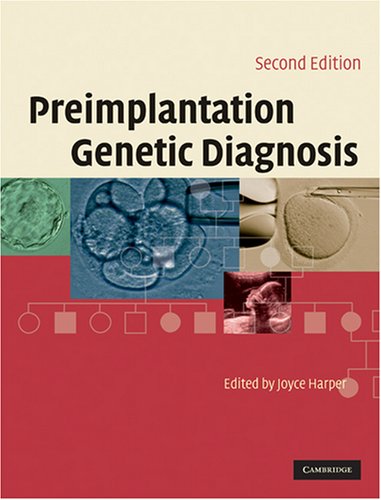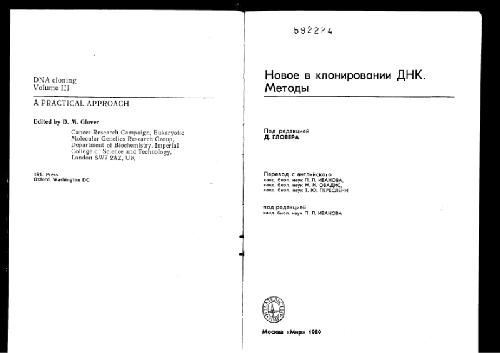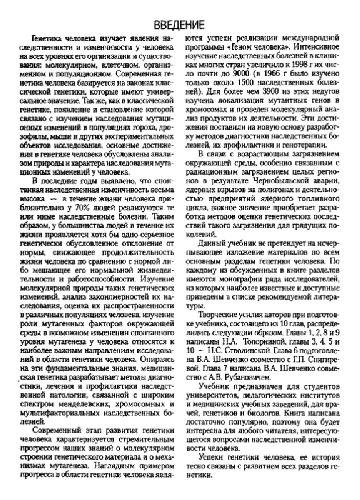Joyce Harper9780521884716, 0521884713, 9780511581571
Table of contents :
Cover……Page 1
Half-title……Page 3
Title……Page 5
Copyright……Page 6
Contents……Page 7
Contributors……Page 8
Preface……Page 10
Introduction……Page 11
Animal studies and preclinical work……Page 13
Development of human embryo biopsy……Page 15
Development of FISH……Page 16
In the USA……Page 19
Development of PCR for monogenic disorders……Page 20
New method of spreading blastomeres and embryos……Page 22
Mosaicism……Page 23
Allele dropout……Page 24
PGD for translocations……Page 25
1998–2008: The last 10 years……Page 26
IVF……Page 29
Genetic disease……Page 30
Genetic counseling……Page 31
Prenatal diagnosis……Page 32
Preimplantation embryo development……Page 33
Preimplantation genetics……Page 34
Clinical aspects of PGD……Page 35
Polar body biopsy……Page 36
Cleavage-stage embryo biopsy……Page 37
Blastocyst biopsy……Page 38
Fish……Page 39
PGD for infertility (PGS)……Page 40
Randomized controlled trials for PGS……Page 41
PCR for monogenic disorders……Page 42
Quality assurance and good practice……Page 43
Future developments……Page 44
Data collection……Page 45
Accreditation and external quality assessment……Page 46
Conclusion……Page 48
References……Page 49
Female infertility……Page 58
Endometriosis……Page 59
Infertility treatments……Page 60
The infertility consultation……Page 61
Assessing ovarian reserve……Page 62
Optimizing response to ovarian stimulation protocols……Page 64
Evaluation of the endometrial cavity……Page 66
Difficult embryo transfer……Page 67
Prevention of ovarian hyperstimulation syndrome……Page 68
Oocyte collection……Page 69
Culture medium……Page 70
Processing of microsurgically derived spermatozoa……Page 71
Fertilization check……Page 72
Examining nucleoli……Page 73
Embryo transfer……Page 74
Treatment success……Page 75
Regulation……Page 76
References……Page 77
Gene mutations and polymorphisms……Page 83
Autosomal recessive inheritance……Page 84
Autosomal dominant inheritance……Page 85
Fragile X syndrome……Page 87
Numerical chromosome abnormalities……Page 88
Chromosomal translocations……Page 89
Inversions……Page 90
Mitochondrial disorders……Page 91
Conclusions……Page 92
References……Page 93
Introduction……Page 95
Family history and past experience……Page 96
Outcome of genetic counseling……Page 97
Review of risks……Page 98
Late-onset disorders……Page 99
Impact of PGD on affected children……Page 100
Conclusion……Page 101
References……Page 102
Introduction……Page 105
Screening versus diagnostic tests……Page 106
Diagnosis of structural anomalies in the first trimester……Page 107
Other markers of aneuploidy in the first trimester……Page 108
Diagnosis of structural anomalies in the second trimester……Page 109
Second-trimester identification of “markers”……Page 110
Maternal serum screening in prenatal diagnosis……Page 112
Detection of Down syndrome……Page 113
Chorionic villus sampling……Page 115
Fetal blood sampling……Page 116
Fetal tissue or body fluid sampling……Page 117
Cytogenetics and prenatal diagnosis……Page 118
Cell free fetal DNA……Page 120
Choice of invasive test in prenatal diagnosis……Page 121
References……Page 122
Introduction……Page 127
Meiosis……Page 128
Oogenesis……Page 129
Oocyte growth……Page 130
Oocyte polarity……Page 131
Oocyte maturation……Page 132
Sperm activation and the acrosome reaction……Page 133
Sperm–oocyte fusion……Page 134
Centrosomes……Page 135
Imprinting……Page 136
Zygote genome activation……Page 137
Compaction……Page 138
Cavitation……Page 139
Metabolic requirements of the early mammalian embryo in vitro……Page 140
Fragmented embryos……Page 141
Conclusion……Page 142
References……Page 143
Introduction……Page 147
Male infertility and meiotic anomalies……Page 148
Aneuploidy in male and female gametes……Page 149
The aneuploidy rate in human oocytes……Page 153
Aneuploidy in early human embryos……Page 154
Mosaic aneuploidy……Page 155
Mechanisms leading to aneuploidy in early embryogenesis……Page 156
Other mechanisms leading to mosaic aneuploidy in embryos……Page 157
References……Page 158
Introduction……Page 161
Chromosome abnormalities……Page 162
Autosomal dominant disorders……Page 163
Mitochondrial disorders……Page 164
Inclusion criteria and individual patient selection……Page 165
Gynecologic and genetic work-up……Page 166
Counseling……Page 167
Pregnancy rates……Page 168
Misdiagnoses……Page 170
Follow-up of PGD children……Page 171
References……Page 172
Technical aspects: methodology……Page 176
Laser-assisted biopsy……Page 177
Transfer of polar bodies onto glass slides for aneuploidy screening or translocation analysis……Page 178
Polar body fragmentation……Page 180
First and/or second polar body biopsy……Page 181
References……Page 182
Introduction……Page 185
Laser……Page 186
Extrusion……Page 187
Diagnostic and strategic considerations……Page 189
Number of cells to biopsy……Page 190
Post-biopsy development……Page 191
References……Page 192
Introduction……Page 196
Technical aspects: methodology……Page 197
Type of cells for analysis……Page 198
Time available for genetic testing……Page 199
Conclusions……Page 200
References……Page 201
Introduction……Page 203
Reproductive risk assessment……Page 204
FISH probe selection……Page 205
Lymphocyte FISH work-up……Page 207
Reproductive risks……Page 209
Conclusion……Page 210
References……Page 211
Introduction……Page 213
Chromosome abnormalities and embryo selection……Page 214
Which cells to biopsy?……Page 215
Cell fixation……Page 216
Number of chromosomes analyzed……Page 217
Error rate criteria and differences between centers……Page 218
Mosaicism and error rates……Page 220
Reduction in trisomic offspring……Page 221
Decrease in spontaneous abortions……Page 222
Increase in implantation, pregnancy, and take-home baby rates……Page 223
Other indications for PGS……Page 226
Reduction in spontaneous abortions in patients with idiopathic RM……Page 227
Toward a full chromosome count……Page 229
Comparative genomic hybridization……Page 230
DNA micro-arrays……Page 231
References……Page 232
Introduction……Page 240
FISH: sexing only……Page 241
PCR: preimplantation genetic haplotyping……Page 242
Allowing choice of sex after PGD for X-linked disease……Page 244
References……Page 245
Introduction……Page 247
Failure of amplification……Page 248
Contamination with extraneous DNA……Page 249
How does it work?……Page 250
The development of a single-cell multiplex PCR……Page 251
Double ARMS……Page 252
Preimplantation genetic haplotyping: major breakthrough or hype?……Page 253
References……Page 255
Introduction……Page 257
Postanalytic……Page 258
Analytic……Page 259
PCR tests……Page 261
Process control: routine quality control……Page 262
FISH validation……Page 263
Equipment……Page 264
External quality assessment (proficiency testing)……Page 265
Transport PGD……Page 266
References……Page 267
Unjustified selection……Page 269
To biopsy or not to biopsy……Page 270
Embryo research……Page 271
Informed consent and counseling……Page 272
The medical model……Page 273
Dominant, “mid-life” onset, untreatable disorders……Page 274
PGD for mitochondrial disorders?……Page 275
“Superbabies?”……Page 276
“Dysgenic” PGD?……Page 277
Intermezzo: autonomy or heteronomy?……Page 278
PGS for triploidy……Page 279
Comprehensive genetic screening: “the transparent embyro”……Page 280
References……Page 281
Does embryo biopsy adversely affect embryo development?……Page 284
Developments in genetic testing……Page 287
Can chromosome and/or genetic testing of embryos tell us anything about embryo viability?……Page 291
References……Page 292
Index……Page 296







Reviews
There are no reviews yet.